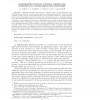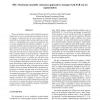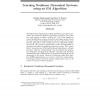114 search results - page 19 / 23 » Maximum Likelihood Identification of a Dynamic Robot Model |
107
click to vote
TASLP
2002
15 years 5 days ago
2002
This paper presents a framework for maximum a posteriori (MAP) speaker adaptation of state duration distributions in hidden Markov models (HMM). Four key issues of MAP estimation, ...
122
Voted
ICML
2000
IEEE
16 years 1 months ago
2000
IEEE
Humanoid robots are high-dimensional movement systems for which analytical system identification and control methods are insufficient due to unknown nonlinearities in the system s...
123
click to vote
CDC
2008
IEEE
15 years 7 months ago
2008
IEEE
Abstract. Differential repetitive processes are a distinct class of continuous-discrete twodimensional linear systems of both systems theoretic and applications interest. These pr...
154
Voted
CRV
2009
IEEE
15 years 7 months ago
2009
IEEE
The use of synthetic aperture radar (SAR) has become an integral part of sea-ice monitoring and analysis in the polar regions. An important task in sea-ice analysis is to segment ...
107
Voted
NIPS
1998
15 years 1 months ago
1998
The Expectation Maximization EM algorithm is an iterative procedure for maximum likelihood parameter estimation from data sets with missing or hidden variables 2 . It has been app...



